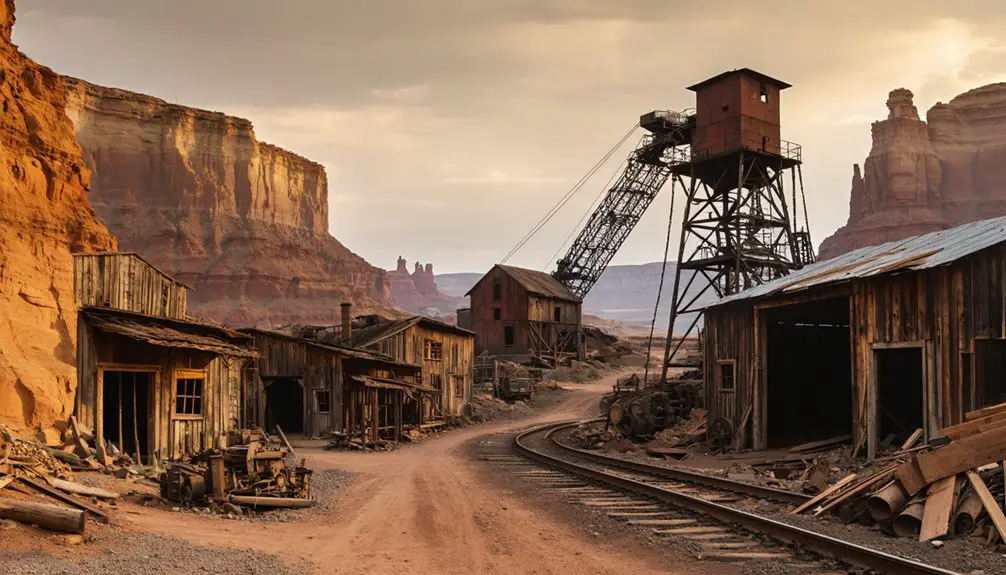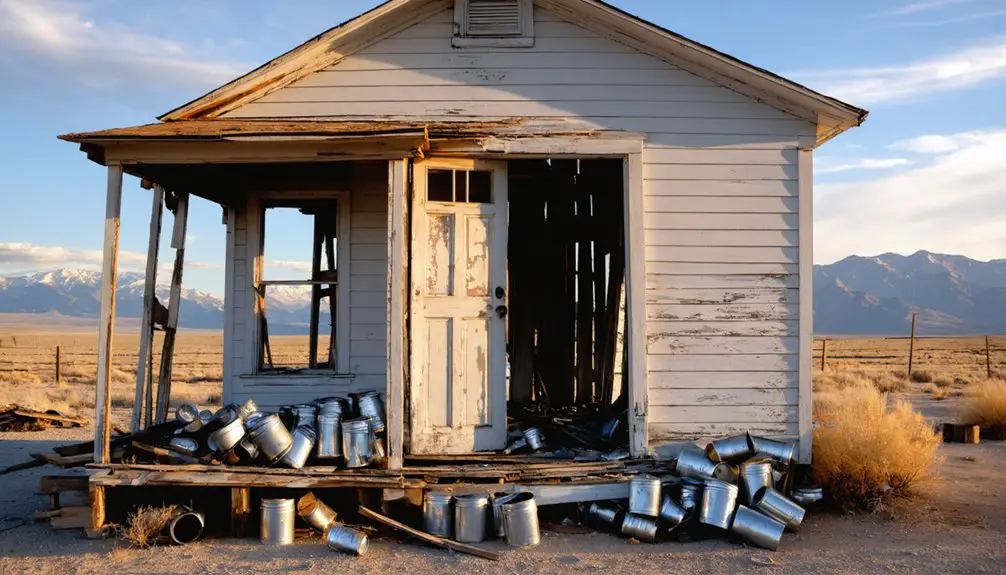You’ll find National, Utah, in Carbon County’s Gordon Creek area, where Arthur E. Gibson’s 1908 coal discovery transformed the landscape into a bustling mining settlement. The town’s distinctive red brick architecture, built from local clay, created a uniform company town aesthetic with Victorian and Classical Revival influences. Though mining operations ended with foreclosure in 1938, National’s preserved structures, equipment yards, and transportation routes offer fascinating insights into Utah’s frontier mining heritage.
Key Takeaways
- National was a Utah coal mining settlement established after Arthur E. Gibson’s coal discovery, becoming the largest mining camp in Gordon Valley.
- The town featured distinctive red brick architecture with granite foundations, using locally sourced materials and Victorian design elements.
- Mining operations began in 1921-1922 with ten workers, reached peak coal shipments in 1927, and faced foreclosure by 1938.
- The settlement shared community services with nearby towns Consumers and Sweet, including healthcare facilities and an amusement hall.
- National’s preserved structures and mining infrastructure now serve as historical remnants of Utah’s frontier mining era.
The Birth of a Mining Town (1908-1920)
Three key developments marked the birth of National, Utah, between 1908 and 1920.
First, Arthur E. Gibson discovered coal in the Gordon Creek area near what would become National, establishing the region’s mining significance. Like most mining towns, National’s early residents were consumers who relied on company-provided goods and services.
Arthur Gibson’s discovery of coal deposits in Gordon Creek marked the beginning of National’s rich mining heritage.
Second, Gibson secured 1,500 acres of land to develop coal operations, and the original settlement bore his name in recognition of his pioneering role.
Third, while early mining remained small-scale and exploratory, the National Coal Company‘s arrival set the stage for formal operations.
The community origins began taking shape when the National Coal Company developed the mining camp, naming it National.
You’ll find it was one of three interconnected mining settlements in Gordon Valley, alongside Consumers and Sweet, forming the foundation of what would become a significant coal mining district.
In the winter of 1921-1922, Gibson expanded operations by hiring ten mine workers to begin more extensive coal extraction.
Red Brick Legacy: A Uniform Company Town
While many Utah mining towns developed organically, National’s architectural identity emerged through deliberate planning centered on uniform red brick construction. The town’s brickyard history reflects the broader Utah tradition of local clay production, pioneered by craftsmen like Noah L. Shurtliff. Similar to how city hall commenced in April 1965 with a remodeled building from Verdland Park, National’s structures showcased careful planning and community cooperation.
The use of adobe bricks in many historic Utah buildings demonstrated the resourcefulness of early settlers. You’ll find National’s architectural significance in its cohesive design philosophy and company-controlled development.
- Red brick buildings featured locally sourced granite foundations, connecting structures to Utah’s geology
- Victorian and Classical Revival elements adorned simple, repetitive building designs
- Pressed bricks displayed uniform shapes and colors, reinforcing company identity
- Pent corners and production date stamps linked architecture to industrial heritage
- Company-owned structures housed everything from worker residences to communal facilities
Railroad Development and Transportation Links
Beyond National’s uniform red brick facades lay an intricate network of steel rails that shaped the town’s destiny.
In 1921, you’d have witnessed an essential railroad expansion as National Coal Company and Gordon Creek Coal Company built a significant rail connection linking their operations to Utah Railway in Helper. This new line served three interconnected mining communities: National, Consumers, and Sweets. Utah Coal Railway was initially incorporated in January 1912 before changing its name to Utah Railway months later.
You’ll find that transportation efficiency soared when Utah Railway, established in 1912, connected these local mines to Union Pacific’s broader network at Provo.
The railroad’s presence didn’t just move coal – it sustained the very fabric of community life. Your access to the town’s hospital, post office, and schoolhouse depended on these steel arteries that kept supplies flowing and workers mobile between the interconnected mining settlements. The development of this infrastructure proved vital for building national identity as the railroad united isolated communities.
Daily Life in National’s Mining Community
If you’d lived in National during its mining heyday, you’d have shared essential community services like the post office and schoolhouse with residents from the neighboring Consumers and Sweets camps.
Your monthly paycheck would have included automatic deductions of $1-1.50 for the tri-town medical association, which covered basic healthcare through company doctors and nurses.
You could have spent your leisure time at the centralized amusement hall in Consumers, though your living conditions would have varied considerably based on your position – with mine officials enjoying blockhouses and indoor plumbing while most miners had more basic accommodations. Just like in other mining towns of that era, the community was filled with 23 drinking establishments where workers would gather after their shifts. The town’s development began when the Utah Railroad line connected the Gordon Creek mining operations to Helper in 1921.
Through the interconnected mining camps of National, Consumers, and Sweet, families shared essential amenities that formed the backbone of their daily lives.
These shared resources fostered community bonding while making efficient use of limited infrastructure in the remote mining region. Like the thriving Chinese workers who established cultural centers in other mining towns, these communities developed strong social ties.
- You’d find a centralized post office serving all three camps, streamlining mail delivery for everyone.
- Your children would attend a common schoolhouse alongside kids from neighboring camps.
- You could access healthcare at the shared hospital located in Consumers.
- The amusement hall in Consumers served as your primary entertainment venue.
- Each camp maintained its own store and well, giving you convenient access to daily necessities.
While most homes lacked indoor plumbing, company officials enjoyed better-equipped housing, reflecting the social hierarchy of these mining communities.
This was quite different from nearby Dividend, which was one of the first Utah towns to feature indoor plumbing.
Healthcare and Social Support
While mining was inherently dangerous work, National’s community benefited from an organized healthcare system centered around a shared hospital in Consumer town.
You’d find a model of community resilience in the medical association formed in the 1930s, which charged miners modest monthly fees – $1.50 for families and $1 for single miners – directly from their wages.
This healthcare evolution reflected a thoughtful collaboration between company and union interests. Your healthcare covered doctor visits, nursing care, and medicines, though major surgeries required additional payment.
Beyond medical services, you’d have access to social support through shared facilities like the post office, schoolhouse, and amusement hall.
The community’s welfare system included improved housing with indoor plumbing, enhancing overall health conditions for mining families.
Healthcare and Social Services

Through National’s Mining Association, workers received basic medical benefits that covered workplace injuries and common ailments during the town’s peak operations in the early 1900s.
You’ll find evidence of the town’s healthcare infrastructure in the remains of a small medical station, which once served both miners and their families near the main mining office.
While primitive by today’s standards, these medical services represented a significant advancement for rural Utah mining communities of that era, providing essential care for National’s approximately 300 residents.
Medical Association Benefits
Despite the remote nature of National, Utah, medical associations have played an indispensable role in delivering healthcare and social services to this ghost town’s residents.
They’ve guaranteed healthcare access through coordinated mobile clinics and telehealth options, while providing crucial social support for the community’s unique challenges.
- Established mobile clinics and rotating specialist visits to serve the town’s isolated population
- Facilitated enrollment in Medicaid and other health insurance programs for residents
- Deployed case managers to connect locals with important social services
- Implemented telepsychiatry services to address mental health needs
- Coordinated with local agencies to tackle issues like food insecurity and housing instability
These associations continue to bridge critical gaps in rural healthcare delivery, guaranteeing that National’s residents receive necessary medical care despite their remote location.
Town Healthcare Infrastructure
Before its eventual abandonment, National’s healthcare infrastructure reflected the stark limitations common to early Utah settlements, with residents facing significant barriers to medical care and social services.
Like other rural communities of the era, you’d have found no formal medical facilities or permanent healthcare staff in National. Instead, you would’ve relied on home remedies, visiting doctors, or faith-based healing practices for your medical needs.
Healthcare challenges were intensified by the town’s isolation, requiring lengthy travel for serious medical treatment.
The community’s social services consisted mainly of informal support networks through family, neighbors, and religious organizations.
As economic pressures mounted, particularly during the Great Depression, National’s already minimal healthcare infrastructure deteriorated further, highlighting the vulnerabilities of rural medicine in early Utah settlements.
The National Coal Company Era
Once coal was discovered in 1908, the National Coal Company transformed the area into a thriving mining operation by the early 1920s. The company’s ambitious mining techniques and infrastructure investments shaped the town’s identity, though economic decline would eventually lead to its demise.
- You’d find uniform red brick buildings throughout the town, including special blockhouses with indoor plumbing for company officials.
- Coal shipments began in 1927, making National the largest mining camp in the area.
- The company store served as the commercial hub, while workers shared amenities with nearby Consumers and Sweets.
- Monthly medical fees were automatically deducted from miners’ wages, covering healthcare for families.
Despite peak operations in the 1920s and 1930s, foreclosure struck in 1938, leading to the sale of valuable equipment and infrastructure.

National’s residents relied heavily on neighboring towns for essential services through an interconnected network of community resources.
You’d find that most medical care came from larger settlements nearby, as National itself had limited healthcare facilities during its operational period.
The town’s inhabitants regularly traveled to surrounding communities to access specialized medical treatments, pharmacy services, and emergency care that weren’t available within National’s boundaries.
Community Resource Networks
Several well-established resource networks connected National to neighboring communities, creating a robust system of shared amenities and services.
Through strategic community collaboration and tourism initiatives, you’ll find the town benefited from regional partnerships that enhanced visitor experiences and preserved historical assets.
- Joint marketing campaigns and heritage festivals boosted tourism traffic across multiple ghost town sites.
- Shared emergency services and law enforcement patrols provided essential safety coverage.
- Coordinated volunteer guide programs allowed interpreters to serve multiple locations.
- Regional tourism offices managed common signage, kiosks, and access infrastructure.
- Collaborative educational partnerships helped maintain consistent historical narratives.
These networks strengthened National’s connections to surrounding towns while maximizing limited resources through cooperative agreements.
Medical Services System
Through a coordinated emergency response network, medical services in National relied heavily on shared resources with neighboring communities due to the town’s remote location and limited infrastructure.
You’ll find emergency preparedness was critical, as EMS response times often exceeded 100 miles, requiring visitors to carry personal medical supplies and communicate their travel plans.
Healthcare accessibility depended on volunteer EMS personnel and regional coordination to maximize coverage across this sparsely populated area.
While National once had its own medical facilities, like many ghost towns, it now shares services with surrounding towns to reduce infrastructure costs.
You’ll need to account for specialized transportation requirements, as emergency responders often require high-clearance vehicles to navigate the challenging terrain, which can delay medical intervention in these remote locations.
Architecture and Infrastructure
While many Utah ghost towns have deteriorated over time, their architectural remnants tell a rich story of frontier construction and town planning. The urban decay you’ll find reflects the materials and building styles that shaped these settlements, from adobe structures to industrial ruins.
- Adobe schoolhouses and communal buildings showcase the resourceful use of local materials.
- Wooden sidewalks and frame buildings, though rotting, reveal planned pedestrian corridors.
- Stone and brick commercial structures, like the 1877 Wells Fargo Building, demonstrate more permanent construction.
- Mining infrastructure includes preserved equipment yards and processing facilities.
- Rail lines and transportation routes shaped town layouts around natural resources.
You’ll find these architectural elements preserved in various states, from stabilized museum pieces to weathered ruins, each telling a unique story of Utah’s frontier development.
The Final Days of Mining Operations

As the late 19th century drew to a close, Utah’s once-bustling mining towns began their descent into abandonment.
You’d have witnessed a series of failed revival attempts at Silver Reef’s mines between 1898 and 1950, while Sego’s coal operations struggled through the 1920s and ’30s before economic decline forced their closure in 1947.
Despite the miners’ determination to maintain their livelihoods, forming the Utah Grand Coal Company, devastating fires in 1949-1950 destroyed critical infrastructure.
Mining safety concerns mounted as abandoned shafts smoldered and water scarcity plagued operations.
The post-WWII economy didn’t favor these small-scale ventures, especially with competition from larger, mechanized operations elsewhere.
What Remains Today: A Ghost Town’s Legacy
Today’s visitors to Utah’s ghost towns will find a compelling mix of weathered structures and carefully preserved historical sites that tell the story of the state’s mining era.
Through dedicated ghost town preservation efforts, you’ll discover sites that capture the authentic spirit of frontier life while safeguarding their cultural significance for future generations.
Ghost towns stand frozen in time, telling stories of Utah’s frontier past while preserving these precious windows into history.
- Original Wells Fargo Office and Cosmopolitan Restaurant still stand at Silver Reef, complete with the building’s historic vault
- Adobe schoolhouses and wooden sidewalks remain in Grafton, despite challenges from Virgin River flooding
- Industrial ruins dot Silver City and Sego, including remnants of company stores and mining facilities
- Archaeological evidence of Silver Reef’s Chinatown lies scattered in the surrounding desert
- The spiritualist Home of Truth compound’s structures endure as evidence of Utah’s diverse historical movements
Frequently Asked Questions
What Was the Total Population of National During Its Peak Years?
Like many ghost towns that whispered their final stories into history’s winds, National’s historical significance suggests you’d have found around 1,000-2,000 residents during its peak mining years in the 1880s.
Were There Any Major Mining Accidents or Disasters in National?
While historical incidents at National’s mines aren’t well-documented in mining safety records, you won’t find any major disasters recorded there like those that devastated other Utah coal mining communities.
What Happened to the Residents After the Town Was Abandoned?
Like scattered seeds in the wind, you’ll find the residents’ relocation took them to nearby growing towns. Despite brief attempts at town revival through uranium mining, they never permanently returned.
Did Any Famous or Notable People Come From National, Utah?
You won’t find any famous residents from National’s brief history. No records indicate anyone of historical significance emerged from this small mining town during its short-lived existence from the 1920s-1950.
Are There Any Ghost Stories or Legends Associated With National?
Unlike other haunted locations where spirits dance through time, you won’t find documented ghost stories or local folklore specific to National. The town’s legacy rests more in its mining history than supernatural tales.
References
- https://en.wikipedia.org/wiki/National
- https://www.legendsofamerica.com/national-utah-ghost-town/
- https://www.myutahparks.com/basics/history/historic-towns/
- https://www.utahoutdooractivities.com/four-utah-ghost-towns.html
- https://www.youtube.com/watch?v=FLdClYRU0bY
- https://jacobbarlow.com/2020/03/28/consumers-utah/
- https://en.wikipedia.org/wiki/Consumers
- https://www.utahlifemag.com/blog/post/4-ghost-towns
- https://en.wikipedia.org/wiki/Kimberly
- https://harrisvillecity.gov/history/



